With time and practice, caring for a houseplant becomes second nature. However, the real difficulty comes when addressing unforeseen problems that quickly arise. To provide just one example, have you ever seen fuzzy white balls popping out of nowhere in your yard? How did they get there, and what should we do about it? Find out what are those white fungus balls in soil by reading on!
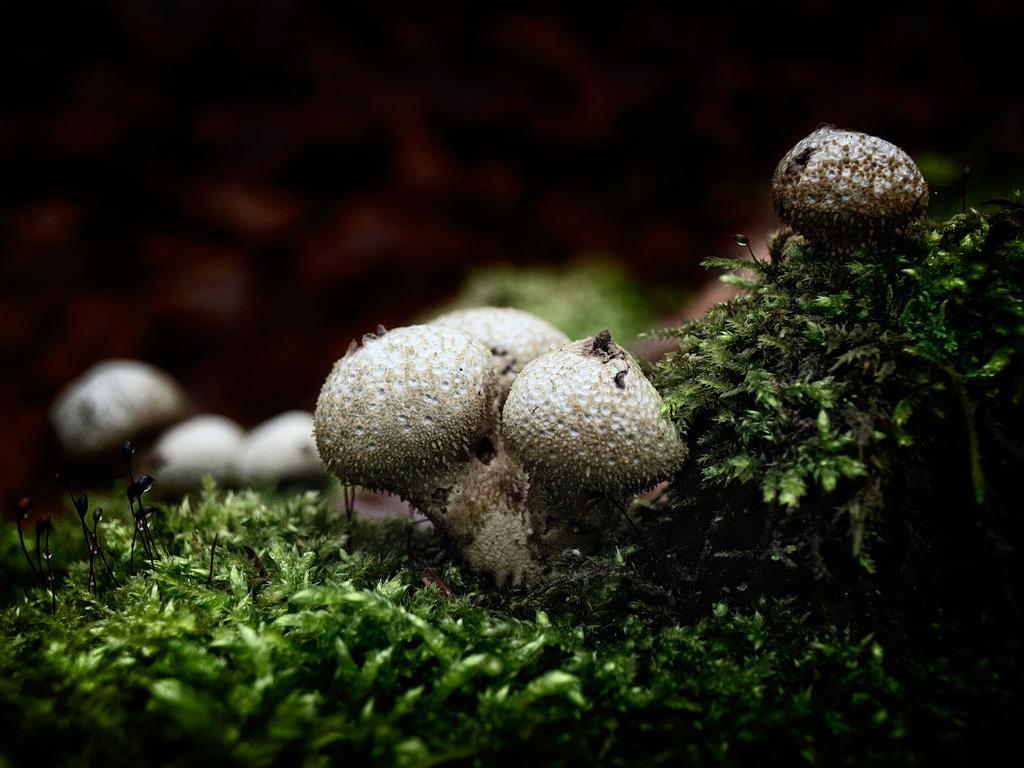
Seeing unsightly white balls in the soil growing around your plants can be very concerning.
Mother nature in the wild has everything arranged for the best growth of all organisms, including plants. However, keeping plants in your backyard is a different story. Now, rather than relying on nature to supply your plants with all they need, you must do so yourself.
Furthermore, plant owners also need to keep an eye out for anything that could harm the plants, such as little white balls that emerge from nowhere in the garden soil.
These white balls in the soil are likely fungi, and they might be anything from huge puffy balls to clusters of little white eggs. However, they could also be the eggs of snails, lizards, or other insects, or they could be perlite balls that had been applied as a soil amendment to improve drainage and aeration in the garden.
So let’s examine what it means when white balls show up in your garden, whether they’re dangerous to people or animals, and how you can get rid of them for good.
White Fungus Balls In Soil

In most cases, the presence of fungus balls in the soil is harmless.
To begin, the most important: don’t lose your cool! They are most likely a category of fungi known as saprophytic fungi, and they are pretty common in the soil.
Also, it is not a pathogenic or toxic fungus. However, if left to grow, you may end up having mushrooms. Mushrooms, you see, have two parts: an underground mass that lives in the soil for an extended period and aboveground balls that appear and disappear swiftly.
Nevertheless, fungi are frequently viewed with skepticism and a degree of risk when it comes to comprehending their relative toxicity to humans and animals.
Therefore, it is in your best interest to investigate the matter further in order to identify the distinguishing features of these white balls. So, let’s get started…
RELATED: How To Identify and Control Black Medic Weed In A Lawn | A Comprehensive Guide
Identifying White Fungus Balls In The Soil
The white fungus balls that you see in your soil are actually enormous colonies of fungi. These balls could come in various shapes, sizes, and forms. Depending on the fungus causing them, the type of fungal balls you may see will vary.
However, there are so many different fungi that it might be difficult to tell them apart.
In fact, researchers estimate that there could be anywhere from 2.2 million to 3.8 million different kinds of fungi on earth. Nevertheless, the following is a list of the most common types of fungi that you may find in the soil of your garden:
Puffballs
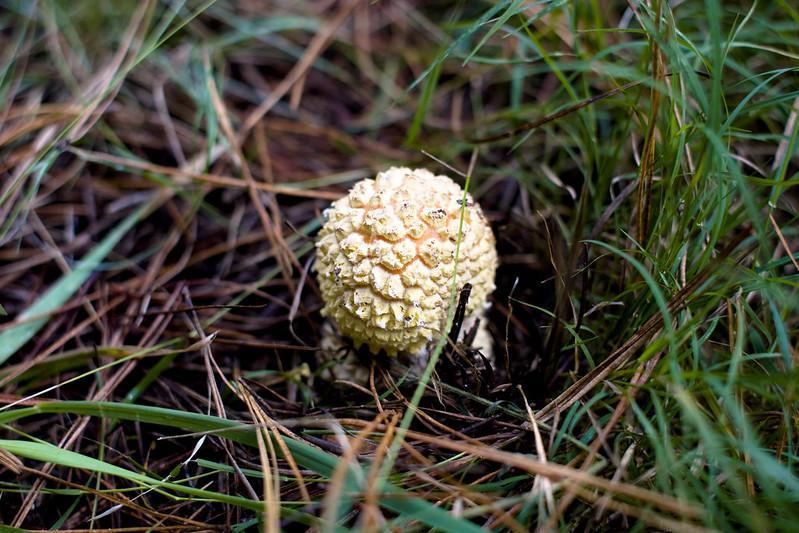
Starting spherically becoming slightly flattened or club-shaped, puffballs are found in soil or on decaying wood.
Puffballs are so named because, when they are in their adult stage, they give out brown spores into the air when they are punctured by something.
Even if they are not broken, they will eventually release their spores once the outer layer of their casing has gotten so dry that it has cracked. They frequently take on the appearance of a completely round ball, similar to a golf ball, although occasionally, they take on more of a pear shape.
Puffballs are also capable of reaching very huge sizes, sometimes even approaching the proportions of a watermelon rather than a golf ball.
Therefore, if you find fungus in your soil that has the appearance of golf balls, there is a good possibility that they are puffballs. In addition, the color of a puffball can range from very pure white to a creamy tone.
Stinkhorns

The stinkhorn is an egg-shaped fungus with an overall phallus-like appearance.
In contrast to puffball, which refers to a wide variety of fungal families and species, stinkhorn only belongs to the Phallaceae family of fungi. This family of fungi is most well-known for the putrid smell that they give off and the sticky spores that they produce.
Nevertheless, stinkhorn balls, much like puffballs, do not in and of themselves pose a threat to your plants. Having said that, considering that stinkhorn fungi can grow fairly huge and tall, along with the fact that they smell terrible, it is good enough of a cause to get rid of them as quickly as possible in order to keep your plant healthy.
When I initially came across Stinkhorns, I mistook them for some unusual kind of snake eggs. It was quite similar in texture to a seedless lychee that had been removed from its skin. I picked it up and squeezed it to get a feel for the texture, but unfortunately, I ended up bursting it. I highly suggest that you don’t do that!
Why Does Fungus Grow In Your Yard?

Fungi thrive in soil that is wet, warm, and rich in organic matter.
The most likely explanation for the appearance of white fungus balls in the soil of your houseplant is the incorporation of pre-infested organic material, such as compost. White fungus balls thrive in conditions in which decomposing organic matter is present. In addition to this, they thrive in wet settings and can experience rapid growth in these conditions.
All in all, the presence of fungus balls in your yard’s soil is most likely due to the high proportion of organic matter present, the hot and humid conditions inside the soil, excessive watering, or a combination of any of these factors.
Continue reading to learn more about these causes.
High Concentration Of Organic Matter
Make sure that there is no dead plant material or other organic materials in the area where the fungus is located if you do not want it to spread. As with bread, any organic materials in or on the soil can serve as an ideal incubator for a fungus to begin its growth.
Therefore, if you have a habit of adding an excessive amount of compost and mulch to your soil, it is possible that your plant may suffer from recurring fungal assaults.
In conclusion, if you recently introduced compost to the soil, you might want to check on all the plants you used the same compost on in case the soil around them starts showing fungal growth.
Overwatering
It is possible to overwater the soil if you continue adding water to it without first allowing at least the soil’s top layer to dry.
Additionally, the water will not evaporate at the appropriate rate if the ground does not drain well. Instead, it will become absorbed by the soil, which will cause it to become saturated and murky. And fungi thrive in such soil.
High Humidity
When soil is overwatered, humidity levels rise. It can also happen if the soil you use is excessively compact, resulting in poor drainage and a lack of airflow. And as soil humidity rises over what it should be, the population of these fungi expands exponentially. Fungus colonies form on their own accord, and when they do, they appear as white balls.
Using Excessive Grass Clippings
Another factor that favors the growth of white fungi is the excess use of grass clippings in the yard soil. Particularly grass that has not been decomposed and is being used solely as a mulching material. It breaks down over time and enables the native fungal species to produce puffballs and other fungi with a similar appearance when the soil is watered.
Weather & Season
Some times of the year are more favorable for the growth of hard white fungus in the soil of a garden or potting soil.
Changes in daylight, temperatures, and humidity levels can all influence this process to varying degrees. In most situations, we have seen many fungus balls sprout from the soil during the late summer and early fall months.
Are White Fungus Balls Harmful To Plants?

Although there is usually nothing to worry about, you should not sit back and relax.
Even though the white fungus balls in the soil are harmless, they can become a nuisance over time if they are allowed to develop freely without being controlled.
In the right conditions, fungi, puffballs, molds, and even bacterial colonies can multiply rapidly, posing a severe threat to the aesthetics of your garden. In addition, their slimy stalks can shoot upward from the fruiting bodies and spread a terrible smell around your plants.
Therefore, if you care about how your gardens and pots look, you should try to remove any fungus balls that might have grown there.
Aside from that, white fungus balls are entirely safe to deal with. Only a tiny percentage of fungi, referred to as pathogenic fungi, have the potential to be destructive and are responsible for things like plant disease.
Most of the fungi found in garden soil are usually considered beneficial. This is because fungus decomposes organic stuff, converting it into a nutrient-rich source for your plants.
Fungi also contain nutrients that are important to soil and plant health. Lastly, the white balls on your plants are most likely harmless and won’t kill your plants.
RELATED: What Are The Little White Things in Plant Soil 8 Ways to Get Rid of Pests?
How Long Does Soil Fungus Live?
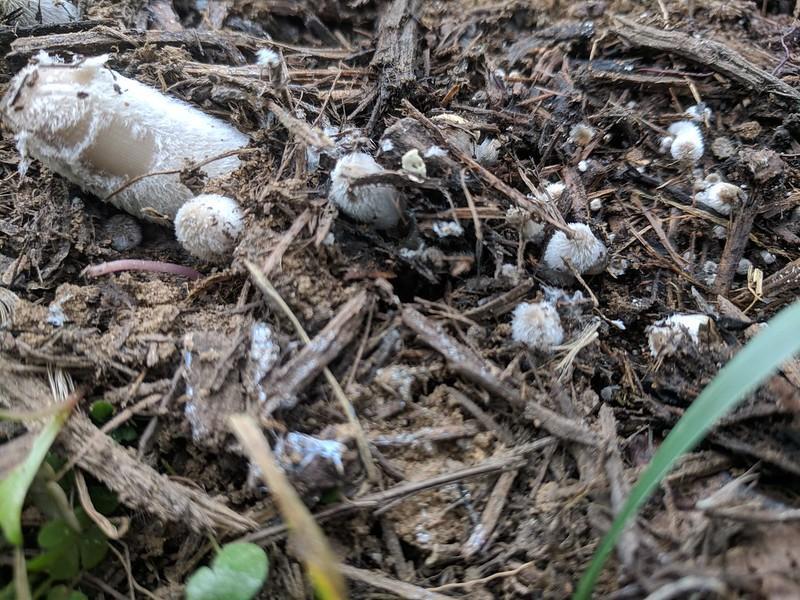
Fungi can live in the soil for long periods, even when there isn’t enough water.
It’s possible for fungi to live in the soil for a very long time; some species, like Verticillium, can live for up to ten years. In addition, fungal spores can survive for up to fifty years in a dormant, vegetative condition when they are in the form of spores.
This helps the fungus to maintain its viability by entering a dormant state until conditions are favorable again. Fungal life can persist in the soil for a long time in the form of spores, hyphal fragments, and decaying plant roots, even under water scarcity.
Therefore, physically removing the white fungus balls in their soil does not mean that the problem has been solved. Instead, the fungus has a body that is buried underground. This is the portion of the fungus that has the potential to lie dormant for an extended time before producing visible fungus balls under the appropriate conditions.
How To Get Rid Of Fungus Balls In The Soil?
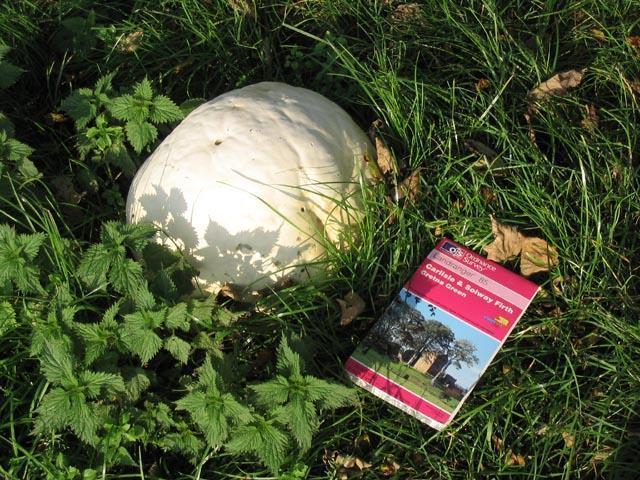
If the fungal infection isn’t killing your plants, there’s no need to treat it with fungicide.
Eliminating white fungus balls is a simple and straightforward process. The vast majority of the fungi perish on their own when a certain amount of time has passed or when they cannot locate anything to consume.
However, the difficulty connected with getting rid of the white fungus balls in the soil frequently relies on the intensity of the infestation, with larger infestations requiring more harsh methods.
You may get rid of fungal balls by hand picking them off, replenishing the topsoil, and eliminating any other organic material that may be present in the soil. As a last resort, you can also use fungicides.
However, there is little point in treating the fungal infection with fungicide if it is not harming your plants. The following is a detailed explanation of the most effective strategies for removing white fungus balls from soil:
Use Natural Compounds
Neem oil and baking soda are two natural remedies that can be used to cure fungus that is found in the soil. Both of these things are ubiquitous in most homes and simple to source. In addition, they are gentler on the plants than commercial fungicides.
Nevertheless, combine one tablespoon of baking soda, one teaspoon of dish soap, one tablespoon of vegetable oil, and one gallon of water in a mixing bowl.
Pour this water into the soil that is affected on a weekly basis without fail. Also, do this in the morning or around lunchtime for optimal results.
Apply A Fungicide
Fungicide treatment of fungi is an effective method for removing unwanted fungi from an area. You can also eradicate the white fungus from the soil and your plants by using a few different home remedies. These days, liquid copper fertilizers are the most effective, and you can quickly place an order for them anyplace.
Nevertheless, ensure that the instructions on the label are followed to the letter, down to the last word. In addition, you should apply fungicides, either organic or inorganic, in moderate amounts to the soil. To make a diluted solution, mix one teaspoon of the fungicide with one gallon of water and then stir the mixture.
In addition, the best course of action would be to take precautions against being exposed to these chemical fertilizers. Rashes and allergic reactions, ranging from mild to severe severity, are very common occurrences.
Bottom Watering
One of the best ways to protect your houseplants against fungal disease is to let the soil dry out completely between waterings, especially the topsoil.
After that, pour some water into the saucer that’s been sitting at the bottom of the pan. The ground will soak up this water, and it will eventually evaporate. Capillary action is used in bottom watering to ensure that plants only take in the minimum amount of water necessary to survive.
Also, when some time has passed, feel the top layer. If it has a damp feel, this indicates that the soil has been hydrated from below, and you may empty the saucer.
Remove All Organic Matter
We have already demonstrated that large concentrations of organic compounds encourage the growth of fungi. This is why it’s imperative to dispose of it entirely.
Fungi cannot survive in an environment where there is insufficient organic matter because they have nothing to feed on. As a result, the fungus will eventually die.
Let The Soil Dry
Fungi can’t survive in an adverse environment, such as when the soil is too dry; thus, they eventually disappear. This implies you should make sure your lighting requirements are met so that the water evaporates on time.
Additionally, you should only use water in the morning and while the topsoil is dry. However, you can’t completely stop watering the plant because doing so would also be detrimental to the plant that is potted in the soil.
Are Fungus White Balls Harmful To People?
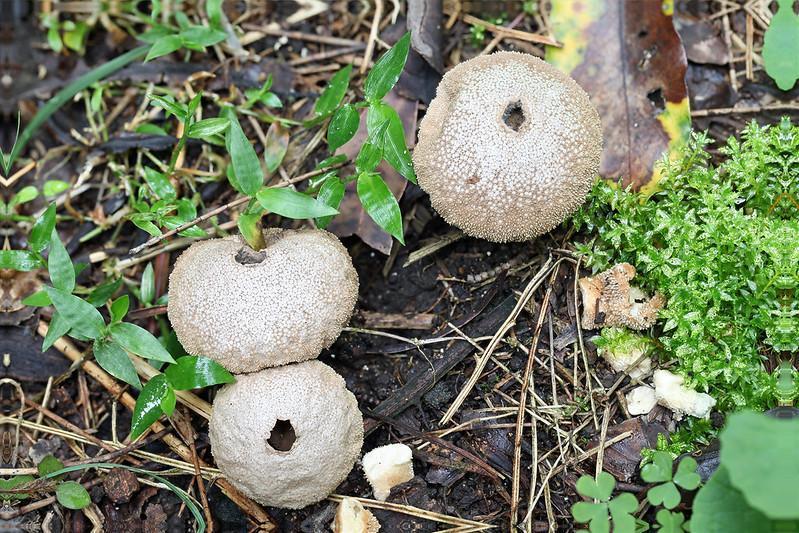
Most fungi are saprophytic, meaning they thrive on dead or decaying organic matter and rarely cause harm.
There is a relatively low incidence of disease in humans caused by mushrooms, and even fewer of them have the potential to cause death.
Unfortunately, however, the appearance of some of the most dangerous mushrooms is very similar to that of harmless varieties. For example, the death cap mushroom, which is responsible for producing the most lethal chemical ever found in nature, is visually similar to the typical white puffball.
In addition, while consuming the wrong mushrooms can lead to various health problems, including damage to the heart, and liver, it is perfectly safe to touch any mushroom.
RELATED: How To Get Rid Of Tiny Clear Worms In The Soil For Good?
Do White Fungus Balls Smell Bad?
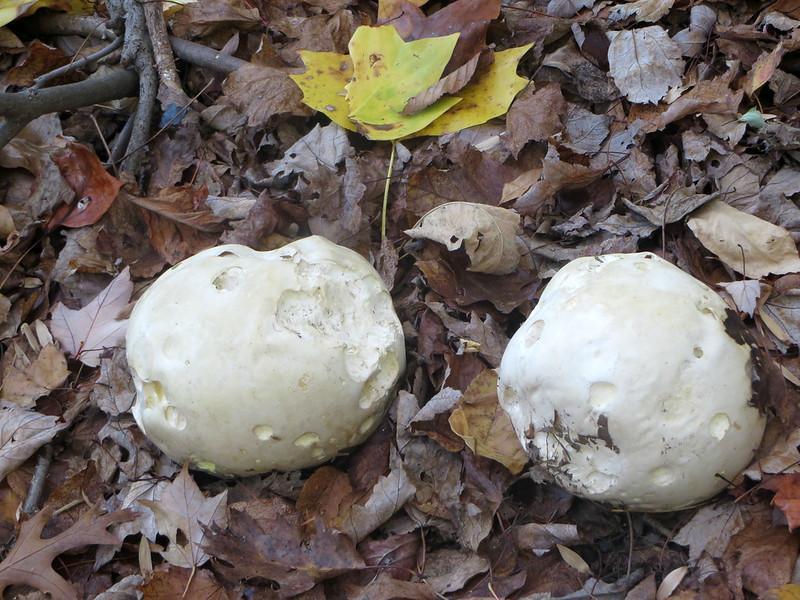
Do the white fungal balls have an unpleasant odor? Some do.
Stinkhorns can grow at a rate of up to four to six inches per hour, which is fast enough for them to generate enough force to crack asphalt when they reach their full size.
And after they have reached their mature form, which resembles a rocket, they stink like a rocket. Thankfully, they don’t stay around for very long.
The putrid odor entices flies, which in turn helps to spread the spores of the mushroom. Therefore, if you are digging in the garden and come across a group of white spheres around the size of a golf ball, you may have uncovered the juvenile buttons of the stinkhorn.
And we highly recommend that you keep your nose covered.
White Eggs In The Soil
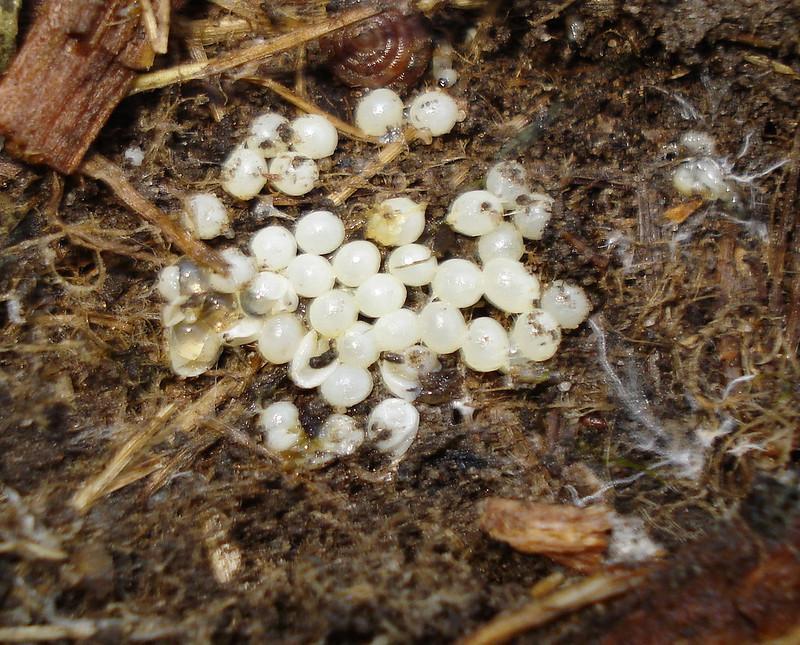
Since insects prefer a dark, nutrient-rich environment, many choose to lay their eggs in the soil.
Numerous animals lay their eggs in the soil. And once they do, all kinds of different living things will be drawn to the soil. The size of the eggs varies from organism to organism.
The following are examples of potential offenders that lay eggs in soil:
Slugs & Snails
Gardeners have to contend with snails and slugs, which can seemingly devastate plants at random. For example, if you find eggs with a gelatinous covering, they may be the eggs of snails or slugs.
Talking about dimensions, they measure approximately half a centimeter in diameter and have an oval shape. Snails, slugs, and other types of crawling insects like to congregate in clean regions that are close to sources of water.
They swiftly hatch and may quickly obtain food. They like to conceal themselves and have their offspring in mulch, garden soil, or even under rocks.
Ants & Flies
Their eggs resemble little clumps of rice. Compared to the eggs of other insects, their eggs hatch much more quickly.
Fungus gnats are just one of fifteen fly species known to lay eggs in the soil. Among these families, eight have only one member.
Two species from each of the five remaining families have pupating larvae. On the other hand, ant eggs are not very large, white, and shaped like an oval. In most cases, they come into being during the spring, when the weather is mild enough for eggs to hatch.
Snakes & Lizards
Snakes and lizards are often constantly moving from one location to another. They can lay eggs in a protected environment that is also adequately moistened. A few species of snakes and lizards also lay their eggs within dead trees, compost, or dung.
The form, firmness, and general appearance of snake and lizard eggs are just a few telltale signs that can be used to tell if you are seeing a snake egg.
When it comes to color, most lizards and snakes in North America lay either white, off-white, or beige eggs. Lizard and snake eggs are typically smaller than eggs laid by chickens; however, the size can vary greatly depending on the species.
How To Get Rid Of Eggs In Soil?
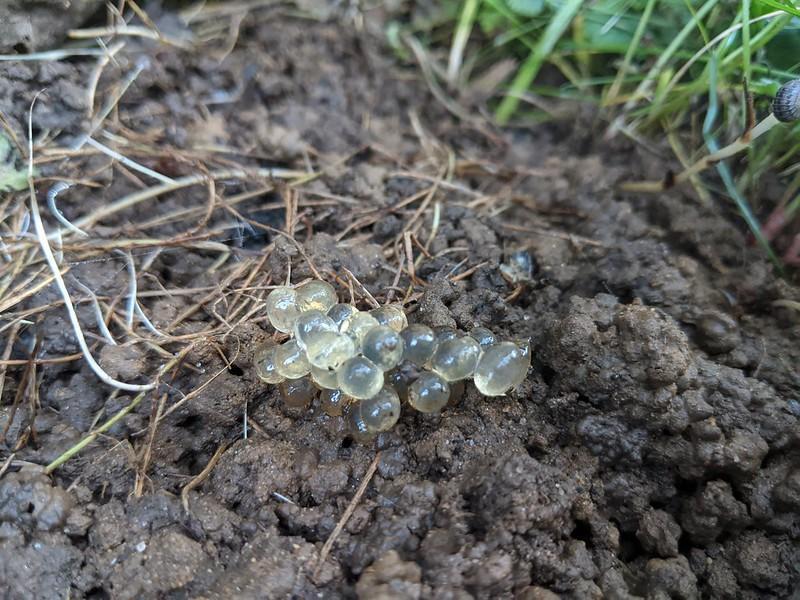
You can get rid of these eggs by simply squashing them.
Before planting a new crop, allowing the soil to become completely dry is an excellent strategy for eliminating eggs. This will lead to the eggs and their slimy protective coating drying out. Also, get rid of any places where animals could lay eggs in the future.
There is also the option of using hydrogen peroxide to get rid of the eggs in the soi. You just need to dilute this chemical by a factor of four with water and then spray it on the eggs and the soil.
Last but not least, restaurants frequently buy certain eggs, such as those of slugs and snails, to use in their cooking. So, you can sell the eggs too.
Perlite White Balls In The Soil
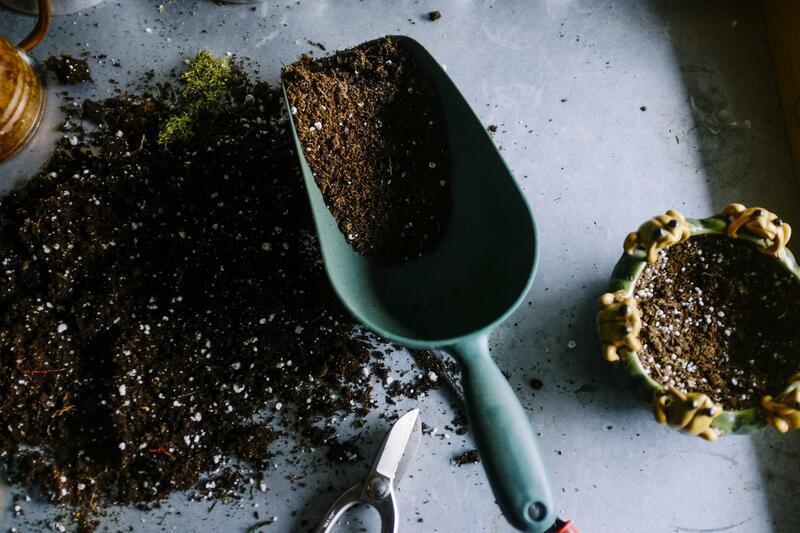
Perlite is a naturally occurring volcanic rock that, when heated, generates micro-porous granules.
If you’ve ever bought potted plants or vegetable starts or opened a bag of commercial potting mix, you might have noticed tiny white balls in the soil that look like bits of Styrofoam. These balls can be removed by sifting through the soil with your fingers.
Contrary to popular belief, these white spheres are not fillers or artificial rocks but rather an essential soil component is known as perlite. A good potting soil should provide your plants with the ideal environment and all the essential ingredients for optimal growth.
Perlite is an example of such an ingredient, and as a result, many manufacturers choose to incorporate it into their potting soil. There are many ways in which perlite improves soil quality. A few examples of these benefits are as follows:
Improves Drainage
Although it has a porous surface that aids in storing water and nutrients, perlite also effectively increases drainage in the growing medium. As an added bonus, perlite is excellent for warding off root rot. It stops the soil from becoming waterlogged, stopping root rot from developing. As a result, it has been shown to be efficient at preventing root rot.
Maintains Moisture
Because of its ability to retain heat, perlite is an excellent choice for indoor gardening; it also protects your plant from invading pests that thrive in damp environments. In addition, studies have shown that perlite hydroponic systems have exceptionally high yields.
Assists Propagation
When it comes to plant propagation in the soil, including planting seeds and taking cuttings, perlite is a beneficial medium to have on hand.
Improves Soil Structure
It functions as a soil amendment. However, rather than correcting nutrient deficiencies, it is used to improve the structure of the soil. It is because the expanded perlite can be helpful in capturing moisture and nutrients in the soil, improving the overall structure.
Improves Drainage
In order to thrive, plants, particularly succulents, require access to an adequate drainage system. A healthy drainage system can be helped by using perlite. The perlite improves drainage and helps maintain moisture by capturing water from the air.
Frequently Asked Questions (FAQs)
How do you get rid of white fungus balls in soil?
Destroying fungal caps in the soil is a simple task. The majority of people simply pluck them and toss them out. However, you can also cut them down with a lawnmower on lawns.
Are white fungus balls poisonous?
Although white fungus balls do not harm plants, they can be toxic. If you have small children living in your house, it is imperative that you take safety measures to protect them from potentially harmful circumstances. Therefore, if you see any of these mushrooms growing on your houseplants, remove them as soon as possible.
Why does my soil keep getting white mold?
The white fungus on the soil is caused by spores of white mold that are naturally present in the soil, but these spores are typically kept in check by the presence of beneficial bacteria.
However, factors such as dampness and a lack of light contribute to the rapid establishment of white fungus. This makes indoor plants the most susceptible to the growth of this fungus.
Are puffballs poisonous to touch?
Most puffballs are safe to eat at any stage of maturity, raw or cooked. However, certain puffball-like mushrooms can be toxic, and while they are not known to cause death in humans, they can make people very sick.
Therefore, before you cook with or consume mushrooms, make sure you have a good understanding of their characteristics.
Is perlite bad for soil?
The use of perlite in the soil is not bad. In fact, it is pretty advantageous. However, perlite is not a fertilizer, and neither plants nor soil can benefit from its nutritional or microbial content. The benefit that it provides is that it helps to maintain a loose soil structure.
Editor’s Recommendations
Bermuda Grass & Shade: What Is The Best Shade Tolerant Bermuda?
How To CORRECTLY Plant St. Augustine Grass Using Plugs? The Ultimate Guide







